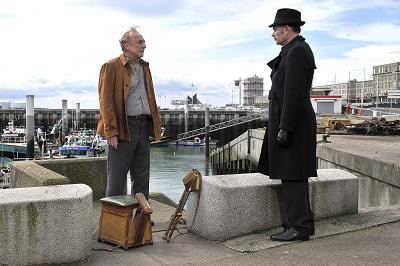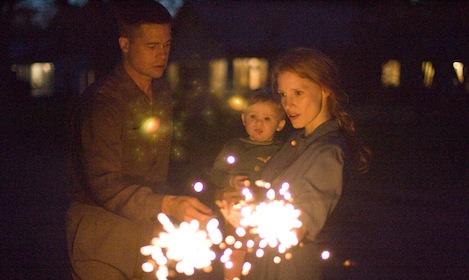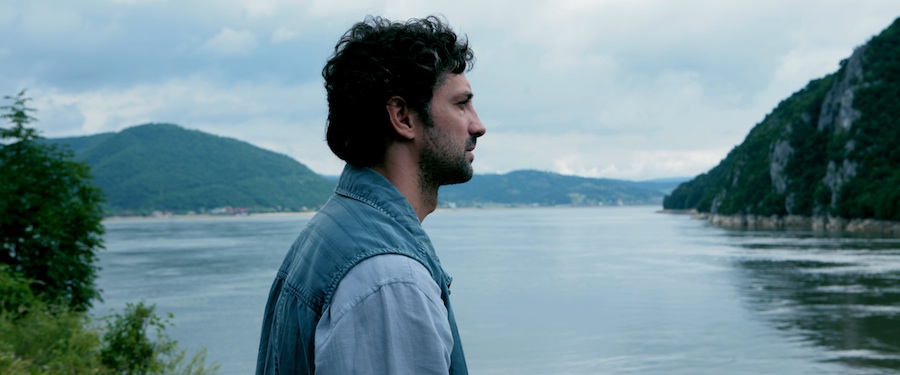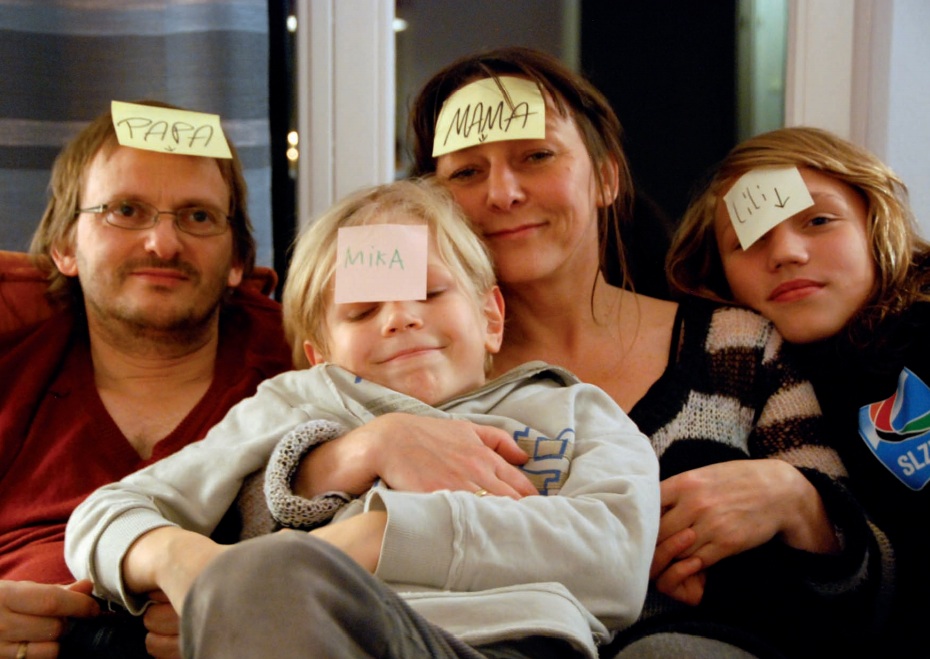Cannes 64 (Teil 3)
By Dorothea Holloway | July 21, 2011
In einigen der eindrucksvollsten Beiträgen von Cannes wurden Lebenswege, Schicksale, Probleme von Knaben behandelt. Bereits der Filmtitel The Kid with the Bike, der auf Preise abonnierten Brüder Dardenne, sagt uns, worum es geht: Der 12-jährige Cyrill ist so unglücklich, wie man nur als Heranwachsender sein kann. Sein Vater hat nicht nur sein “Ein und Alles”, sein Fahrrad heimlich verkauft, sondern den Sohn auch im Stich gelassen. Cyrill kommt in Kontakt mit Ganoven, aber … und so einen glücklichen Zufall können sich nur die Dardenne-Brüder erlauben, Cyrill trifft die allein lebende, warmherzige Friseuse Samantha, die den Jungen bei sich wohnen läßt. Wie Cecile de France diese fürsorgliche, so verständnissvolle, heitere, hübsche, junge Frau verkörpert, hat eben den unverwechselbaren, fabelhaften “Dardenne-Touch”. Wir verlassen das Kino frohen Mutes. Den Großen Preis der Jury gab es in Cannes für Le gamin au velo von Jean-Pierre und Luc Dardenne (Kamera: Alain Marcoen). Die Dardennes teilen sich den Preis mit Nuri Bilge Ceylan (Türkei), dessen Bir Zamanlar Anadolu’da dem Festival zu Ende einen filmischen Höhepunkt bescherte. Übrigens: Auch in Le Havre geht es um einen Jungen, einen Flüchtling, der gerettet wird. Beim Filmfest in München ging der Arri-Preis für die beste ausländische Produktion an Le Havre von Aki Kaurismäki.
In We need to talk about Kevin von Lynne Ramsay (Kamera: Seamus McGarvey) ist dieser Kevin von Anfang an ein sonderbar schwieriges Kind, zu dem die überforderte Mutter einfach keinen Zugang findet. Sie sucht die Schuld bei sich. Es ist wohl nur Tilda Swinton gegeben, diese an Schuldgefühlen leidende, unglückliche Mutter zu gestalten, die zu dem geliebten Sohn, es ist ein Wunschkind, keinen Zugang findet, wie herzzerreißend und alle Unarten des Sohnes erduldend, sie sich auch bemüht. Kevin verweigert sich, je älter er wird; jedoch nicht dem Vater. John C. Reilly überzeugt als Vater, der von all den Schwierigkeiten, dem Mutter-Sohn-Drama einfach nichts mitbekommt oder sich verschließt. Für Kevin gibt es drei Darsteller; Ezra Miller, der neben Tilda Swinton den 15-jährigen spielen darf, ist ein talentierter Bursche.
Topics: International Reports | Comments Off on Cannes 64 (Teil 3)
11th German Films Previews in Hamburg
By Martin Blaney | July 15, 2011
75 international buyers from 33 countries attended the 11th edition of the German Films Previews which was held in Hamburg from July 10-13. The four-day event, which is organised by the promotion agency German Films and is supported by the regional film fund Filmförderung Hamburg Schleswig-Holstein, Studio Hamburg and Hamburg Marketing, presented market screenings at the CinemaxX multiplex of new German titles and international co-productions with German involvement.
The 17-title programme ranged from debutant Tim Fehlmann’s apocalyptic thriller hell, which will have its international premiere in Locarno on August 4, and Christian Zübert’s dramedy Three Quarter Moon (Dreiviertelmond) through Sebastian Dehnhardt’s documentary Klitschko (see review in KINO 100) and Anna Justice’s Remembrance (Die verlorene Zeit) to Robert Thalheim’s Westwind, a melodrama and love story set in Hungary the year before the fall of the Berlin Wall.
In addition, The Match Factory will be showing Stephane Robelin’s drama And If We All Lived Together?, Achim von Borries’ Second World War drama Four Days In May (Vier Tage im Mai), which has been selected for Locarno’s International Competition, and Michael Glawogger’s latest documentary Whore’s Glory.
Also screening were Ziska Riemann’s coming of age drama Lollipop Monster and Christian Schwochow’s Cracks in the Shell (Die Unsichtbare), which both ran in Karlovy Vary’s competition.
In addition, buyers could see promo-reels of such forthcoming titles as Franziska Buch’s family film Yoko, the children’s animation TV series Mullewapp Stories, Barnaby Southcombe’s film noir I, Anna as well as screen films collected in a DVD library.
Topics: German Film | No Comments »
Cannes 64 (Teil 2)
By Dorothea Holloway | July 1, 2011
Le Havre von Aki Kaurismäki hätte von mir auch eine Palme bekommen. Ron und ich lieben ihn und seine Filme. 1992 schrieb Ron in KINO-German Film Nr. 45 u. a.: “Catch Aki’s latest cult film – La Vie de Bohême – at the International Forum of Young Cinema.” Nach 20 Jahren hat Kaurismäki wieder einen Film in französischer Sprache gedreht (Kamera: Timo Salminen). Ganz begeistert bin ich von Jean-Pierre Darroussin; er ist der Polizeiinspektor, der den aus Afrika stammenden Flüchtlingsjungen Idrissa sucht. André Wilms, er gehört zur “Kaurismäki-Familie”, war bereits bei La Vie de Bohême dabei, ist jetzt der Schriftsteller Marcel Marx, der als Schuhputzer arbeitet, um den Arbeitern am Hafen näher zu sein. Marcel Marx nimmt Idrissa bei sich auf und verhilft diesem zur Weiterreise nach London, wo seine Mutter lebt. Sogar die Polizei drückt ein Auge zu. Aki erzählt uns ein Märchen. Ja, warum denn nicht? Wir brauchen Märchen, die gut ausgehen. Wir haben viel zu wenige davon. Marcel’s Frau ist Kati Outinen, langjähriges Mitglied des Aki-Clans. Sie heißt im Film Arletty. Da muss ich an Marcel Carné denken. Vielleicht ist Children of Paradise auch ein Lieblingsfilm von Kaurismäki! Der FIPRESCI-Preis wurde Aki Kaurismaki für Le Havre verliehen. Bravo Fipresci!
50 Jahre Semaine de la Critique
Ein wunderbares Geschenk bekam ich dieses Jahr in Cannes überreicht: Die Publikation 50 Years of Discovery. Stundenlang kann man lesen und blättern in diesem Schatz von einem Buch! Im Editorial berichten u. a. Gilles Jacob, Jean-Christophe Berjon und Thierry Frémaux, wie alles begann. Zitat Eric Garandeau: “La Semaine de la Critique has continued to discover new talent by targeting first and second feature films by filmmakers from all around the world.” Wenn man nur die Namen der Filmemacher liest, über die in den einzelnen Kapiteln berichtet wird, ist es wie ein Gang durchs Paradies der Filme:
“The Sixties: Bernardo Bertolucci, Philippe Garrel, Jean Eustache, Jerzy Skolimowski, Dusan Makavejev, Sembene Ousmane …
The Seventies: Denys Arcand, Merzak Allouache, Victor Erice, Ken Loach, Benoit Jacquot …
The Eighties: John Sayles, Wong Kar-wai, Amos Gitai, Idrissa Quedraogo, Leos Carax …
The Nineties: Guillermo Del Toro, Arnoud Desplechin, Jacques Audiard, Andrea Arnold, Gaspar Noe . . .
The Millenium: Ronit Elkabetz, Alejandro Gonzales Inarritu, Bertrand Bonello, KerenYedaya, Julie Bertuccelli …
La Semaine is still betting on new Talent
Awards, Directors, Selection-Committees, Acknowledgements and Credits”
Auch die über 100 Filmbilder bescheren wehmütige und einmalige Erinnerungen – ein wahres Augenglück. Auf Seite 42 berichtet Pierre Murat über Alexei Guerman. Ron Holloway konnte seinen Dokumentarfilm über Alexei Guerman nicht mehr zu Ende bringen (siehe KINO – German Film Nr. 93 aus dem Jahre 2008). Gregor Sedlag und Barbara Wurm (KINO – German Film-Autorin in Nr. 99) wollen die Dokumentation vollenden. Wir hoffen, dass auch Freunde uns helfen.
Zum 50-jährigen Jubiläum der Semaine de la Critique lud Jean-Christophe Berjon, Artistic Director, zu einer ganz besonderen Vorstellung ein: My Little Princess von Eva Ionesco, Seance Speciale. Auch Thierry Frémaux ließ es sich nicht nehmen, neben der Regisseurin die Hauptdarstellerin Isabelle Huppert und das Nachwuchstalent Annamaria Vartolomei auf der Bühne zu begrüßen. In My Little Princess verfilmt Eva Ionesco ihre eigene Biographie als kindliches, skandalumwittertes Fotomodell ihrer Mutter. Mit den damals entstanden Bildern wurde sie im Paris der 1970er Jahre über Nacht zur Berühmtheit. Es ist ein spannender, autobiografischer Film mit ganz hervorragenden Schauspielern (Kamera: Jeanne Lapoirie).
Melancholia von Lars von Trier
Eine Kaspar-David-Friedrich-Landschaft, mehr Nacht als Tag, nur am Himmel ein faszinierendes Leuchten. “Film ist Bild” habe ich von Ron gelernt. Kameramann Manuel Alberto Claro schuf ein Meisterwerk. Durch den unwirklich-romantischen Schlosspark am Meer galoppiert ein edles schwarzes Ross, Wagners Tristan und Isolde erklingt und eine leuchtend weiße Braut in Kranz und Schleier stolpert durchs Unterholz, Wurzelwerk verfängt sich in ihrem Schleier, zieht sie nieder. Eine Frau mit einem Kind im Arm versinkt mit jedem Schritt tieter und tiefer im Morast eines Golfplatzes. Bedrückende Untergangsstimmung, der Planet Melancholia nähert sich der Erde, das Ende der Welt kündigt sich an.
Braut und Bräutigam im Auto unterwegs. Sie haben Schwierigkeiten: das Luxus-Auto ist zu lang, der Weg zu schmal. Fast zu spät erreicht das Paar ein prächtiges “Märchen”-Schloss, wo von der rührigen Schwester der Braut eine Luxushochzeit zelebriert wird, überaus stilvoll. Es soll ein rauschendes Fest werden, die Gäste sind vom Feinsten: Charlotte Rampling, (Brautmutter) Kiefer Sutherland (Vater), John Hurt, Stellan Skaarsgard, Udo Kier … Alles könnte so schön sein! Nur, die Braut ist so teilnahmslos, leidet unter Melancholie, so heißt doch auch der Vernichtung bringende Planet. Mehr und mehr wird die wunderschöne Braut von Traurigkeit befallen. Sie ruiniert ihre eigene Hochzeit. Die Gäste verschwinden, der Bräutigam auch. Mischt sich in die unendliche Traurigkeit nicht auch ein undefinierbarer Hochmut? Auf den Gedanken bin ich noch nie gekommen. Wie Kirsten Dunst als Braut Justine diese ständig wachsende Depression, diese eigenartige Trance, die sie umhüllt, erfühlt, gestaltet, erfahrbar macht – ist einfach zum Niederknien. Alle Schauspieler, die Lars von Trier für sein Melancholia gewinnen konnte, faszinieren, sind virtuos: Charlotte Gainsbourg als Schwester von Justine, Alexander Skaarsgard als Bräutigam. Auch wenn die Astronomen hoffen, der Planet möge an der Erdkugel vorbeischrammen, Justine weiß es besser, sie weiß, das Ende der Welt ist nahe. Nun kann sie der Schwester beistehen. Oder träumt Justine das alles? Für Dancer in the Dark wurde Lars von Trier 2000 die Goldene Palme verliehen. Dieses Jahr wurde Kirsten Dunst als Beste Schauspielerin in Cannes 2011 ausgezeichnet.
The Artist von Michel Hazanavicius
Die Auszeichnung als Bester Schauspieler erhielt Jean Dujardin als Stummfilm-Superstar George Valentin in The Artist, einer Huldigung an das Hollywood der 20er Jahre. Valentin tritt mit einem putzigen Cockerspaniel auf, der ihm bedingungslos gehorcht. Alle Tricks gelingen. Wir amüsieren uns köstlich und freuen uns über das brave Hundchen. Im überwiegend ernsten Programm von Cannes ist The Artist ein Juwel der Heiterkeit. Zudem, was nur durch Mimik und Körpersprache – ohne gesprochenes Wort – so präzise “rüberkommt”, ist einfach wunderbar. Dann kommt der Tonfilm. Valentins Partnerin, Berenice Bejo, macht als sprechende Schauspielerin Karriere und der stumme Star verschwindet. Es gibt ein paar unerwartete, höchst vergnügliche Überraschungen. The Artist (Kamera: Guillaume Schiffman) gehörte zu den geliebten Favoriten in Cannes. Bei der Preisverleihung bedankte sich Jean Dujardin mit einem Stepptanz.
Topics: International Reports | Comments Off on Cannes 64 (Teil 2)
TIFF Turns 10 – Cluj’s Transsilvania International Film Festival reaches its first decade
By Martin Blaney | June 27, 2011
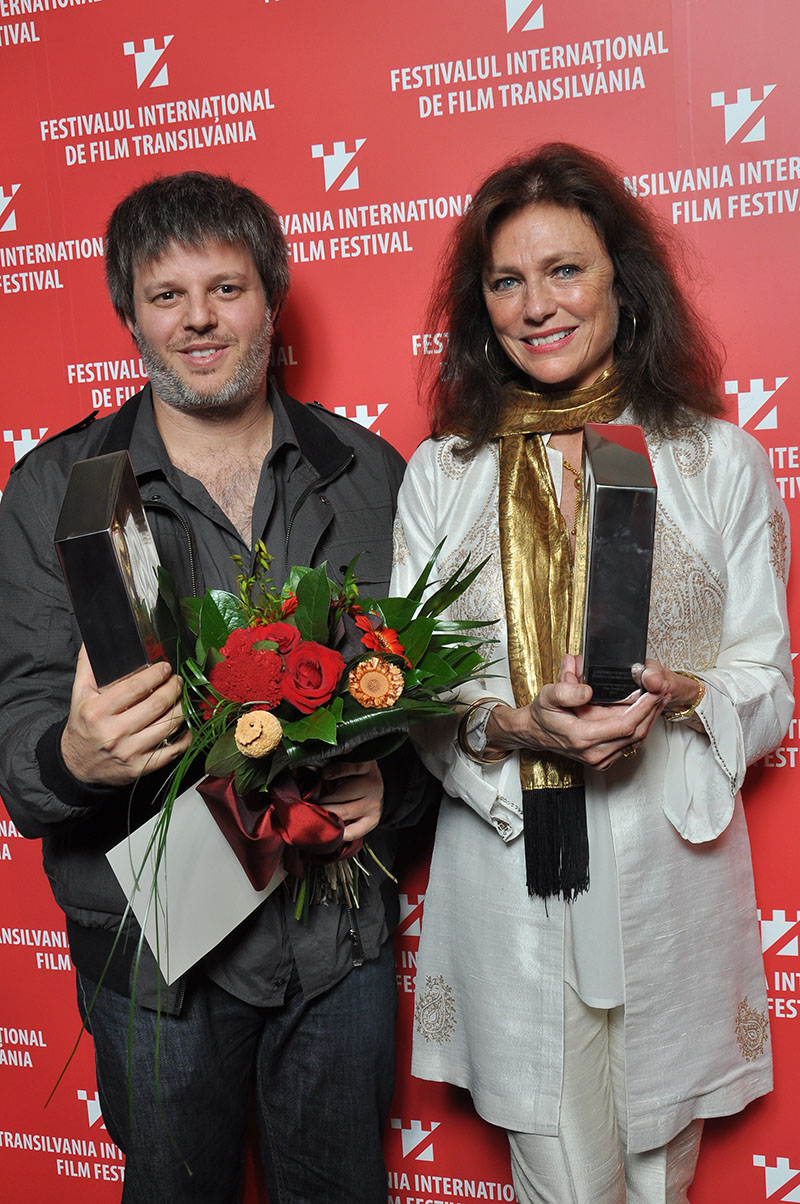
In photo: Transilvania Trophy winner Miguel Cohan with Jacqueline Bisset, courtesy Nicu Cherciu/TIFF
When KINO – German Film’s Ron and Dorothea Holloway attended the first edition of the Transilvania International Film Festival (TIFF) in 2002 with Ron as the first jury president, the fledgling event presented a total of 45 films in just two venues. Ten years later, the festival – running from 3-12 June – has expanded into one of leading international film events with a lineup of some 220 films for its jubilee edition plus several special events dedicated to music, theatre, fashion and photography at 30 venues in and outside Cluj.
In total, around 70,000 admissions were posted for the films and festival events, with daily traffic of between 20,000-25,000 at the key festival venues including the recently refurbished Cinema Florin Piersic (previously known as Cinema Republica). However, the organisers of TIFF haven’t let the festival expand just for the sake of it: president Tudor Giurgiu and artistic director Mihai Chirilov, who were the architects of this annual cinematic feast and have remained at the helm ever since, have ensured that the special TIFF spirit has nevertheless been preserved.
As Giurgiu said in the special edition of AperiTIFF about the first ten years of the festival: „The yearly success of TIFF is a continuous miracle, mostly because this was a project born out of love for film and out of a desperate need for an event which would eventually, hopefully put Romania on the movie map.“
„TIFF has been showing edgy and provocative films, but has also been a great place for encounters,“ he observes. „There is something in the air of Cluj during the festival which makes it unique – I always like to say it’s like in Shakespeare’s Midsummer Night’s Dream: Everything becomes possible.“
Topics: Misc. | Comments Off on TIFF Turns 10 – Cluj’s Transsilvania International Film Festival reaches its first decade
Ten Years After – Transilvanian International Film Festival
By Martin Blaney | June 27, 2011
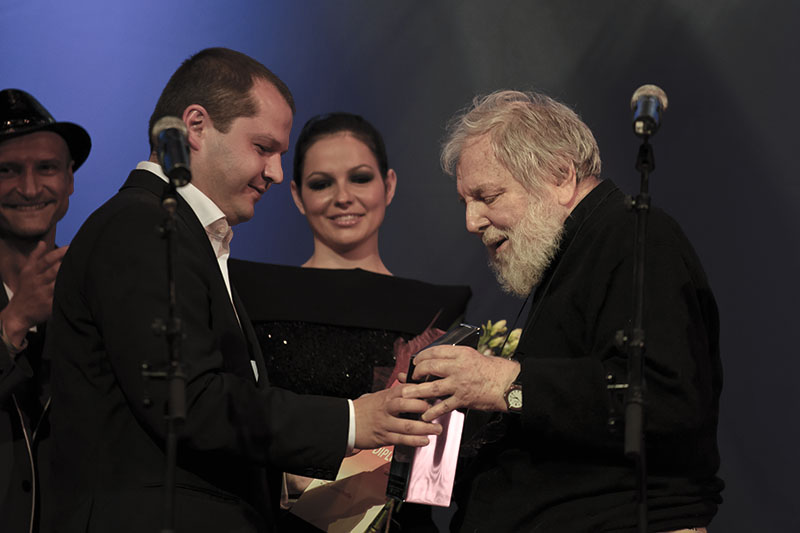
In photo: Lucian Pintilie receives his Excellency Award from Corneliu Porumboiu, with TIFF’s Mihai Chirilov (left) looking on, courtesy Adi Marineci
How time flies. One can hardly believe that it’s now more than ten years since Cristi Puiu’s Stuff and Dough screened at the Directors‘ Fortnight in Cannes in 2001 and Cristian Mungiu’s Occident bowed in the same section the following year. The first edition of TIFF was then staged in 2002 at the beginning of a new chapter in Romanian cinema and was followed at the next Berlinale with a special supplement in KINO – German Film dedicated to the new wave of Romanian filmmakers along with portraits of Lucian Pintilie and Radu Gabrea.
This year’s TIFF saw the publication of the special edition of AperiTIFF – Romanian Cinema 2011, which is the second annual special magazine about contemporary Romanian cinema. Lavishly illustrated and packed with up-to-date information, this magazine is another collaboration by the festival with the Romanian Cultural Institute and Corina Suteu of the Romanian Cultural Institute in New York. As TIFF artistic director Mihai Chirilov explains, the first special issue of aperiTIFF last year had focussed on Romanian cinema in 2010 „because it was an extremely rich year with three films in Cannes and plenty of other premieres. It was the year in the Romanian cinema.“
This second issue, though, is dominated by the number 10 as indicated from the start by the design on the magazine’s cover. One article is dedicated, for example, to the 10 key faces of Romanian cinema – ranging from Luminita Gheorghiu from The Death of Mr Lazarescu to Razvan Vasilescu of California (Dreamin’) as well as such newer faces as Dorothee Petre and Maria Popiastu – while another feature returns to Cristi Puiu’s Stuff and Dough 10 years after its release and juxtaposes a review of the film from today’s perspective with one written 10 years ago as well as presenting testimonials from all of the key members involved in the film such as the actors, DoP, producers, scriptwriters and director Puiu.
Topics: International Reports | Comments Off on Ten Years After – Transilvanian International Film Festival
Cannes 64: Regarding Un Certain Regard
By Gregor Sedlag | June 23, 2011
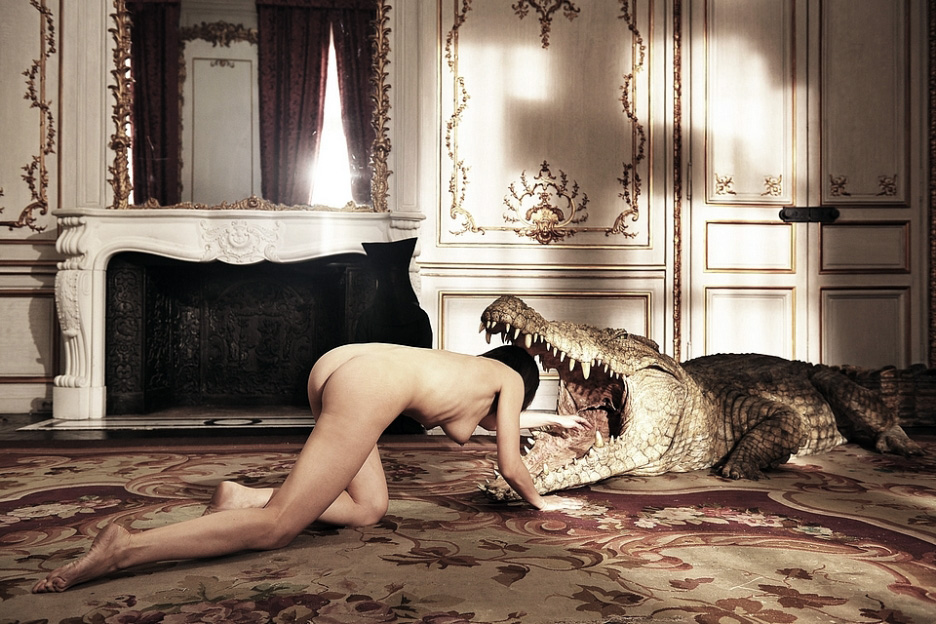
Un Certain Regard sometimes means to risk a glance. Photo from L'Exercise de L'Etat by Pierre Schoeller, courtesy Archipel 35
Apart from reporting on the remarkable success of Andreas Dresen’s Halt auf freier Strecke (Stopped on Track), which was awarded the Prix Un Certain Regard ex aequo with Arirang by Kim Ki-Duk, KINO – German Film remains true to its subheading of „International Reports“ by looking at some of the entries in this year’s Official Selection of the Festival de Cannes and beginning with the inspiring programme of the Un Certain Regard sidebar which perfectly complemented the strong Competition.
In attempting to summarise the films reviewed here, I would say that most of them are following established genre rules, but they provide an added value with their presentation of specific regional settings that far exceed their original genre parameters. Moreover, they offer “a special view” of the world and its people through the art and craftsmanship of their authors, directors, producers, cinematographers and actors. It is testament to the very skill of a film festival programmer to discover such works of cinematic art and put such an impressive selection together as was the case with as this year’s Un Certain Regard.
Here, in alphabetical order, are some of films from the Official Selection’s Un Certain Regard which are featured in this omnibus review:
– Bonsái by Christián Jiménez
– L’Exercice de L’Etat (The Minister) by Pierre Schoeller
– Loverboy by Catalin Mitulescu
– Martha Marcy May Melene by Sean Durkin
– Miss Bala by Gerardo Naranjo
– The Hunter (Okhotnik) by Bakur Bakurdadze
– Skoonheid (Beauty) by Oliver Hermanus
– The Day he arrives by Hong Sangsoo
and Out of Competition:
– Dias de Gracia (Days of Grace) by Everardo Gout
Topics: Film Reviews, International Reports | Comments Off on Cannes 64: Regarding Un Certain Regard
64 Cannes (Teil 1)
By Dorothea Holloway | June 14, 2011
Prelude: Report by Ron Holloway aus dem Jahre 2007, 60. Festival in Cannes
“By all counts, the 60th Festival de Cannes (16-27 May 2007) will go down as one of the best in its distinguished history as the queen of international film festivals. Delegue Artistique Thierry Fremaux achieved a remarkable balance in the Competition, mixing veteran filmmakers with debutantes and blending, in particular, Asian entries with films by American mainstream and European auteur directors. Further, the Competition was backed by a high-caliber Un Certain Regard section.”
Auch über Cannes 64 ( 11-22 Mai 2011) kann ich Ron’s Lob nur wiederholen: Der Wettbewerb war bemerkenswert and was “backed by a high-caliber Un Certain Regard section.” Denn wieder war es gelungen, dass Regie-Großmeister der “Queen” die Ehre eines Besuches erwiesen: Woody Allen – Nanni Moretti – Jean-Pierre et Luc Dardenne – Aki Kaurismäk – Lars von Trier – Pedro Almodovar – Paolo Sorrentino – Alain Cavalier – Gus van Sant – Kim Ki-Duk – Emir Kusturica (in der Jury für Un Certain Regard); nur Terrence Malick war wohl nicht nach Cannes gekommen, – oder doch? Jedenfalls hat mich sein Meisterwerk The Tree of Life tief beeindruckt – ein wunderbares Werk. Danke, Terrence Malick. Und Gratulation an Kameramann Emmanuel Lubezki!
Ron und ich machten in Cannes immer ein sogenanntes “Palmen-Spiel”: ich sagte den Gewinner der Goldenen Palme voraus. Und meine Voraussage war fast immer richtig. So war es auch in diesem Jahr: als am Montag, den 16. Mai vormittags die Pressevorführung von Terrence Malicks The Tree of Life zuende war, wusste ich, das ist die Palme! In den Guide für die Press Screenings schrieb ich: Ron war dabei.
Vom ersten Bild an war ich hineingezogen in dieses expressionistische Wunderwerk, in den betörenden Rausch von Bildern, Klängen, auch Worten – Bibelworte, Szenen aus dem Weltraum, Szenen aus der Kindheit, flirrende Musik, anschwellende Musik – die Moldau – wohl fast eine Stunde gefangen von der Opulenz der Sternenbilder, eine kosmische Schöpfung: Himmel, Erde, Explosionen im All, ein Schwelgen in Planetenwelten. Nur einmal im Leben, ich war noch Studentin, hat mich ein Film so ins Mark getroffen: Les Enfants du Paradis von Marcel Carné. Einen Winter lang sah ich den Film jeden Sonntag um 11 Uhr im Dammtor-Kino in Hamburg.
Dann wird eine Geschichte erzählt, eine Familiengeschichte: fünfziger Jahre im Mittleren Westen der USA. Von den drei Söhnen stirbt der Mittlere; die liebende Mutter (bewegend Jessica Chastain) ist vor Schmerz wie gelähmt. Der strenge Vater erzieht die Söhne mit “väterlicher” Härte – gnadenlos. Es gibt Zeitsprünge und Ortswechsel, die Figurenzeichnung ist klar und einleuchtend. Mal ist der älteste Sohn Jack noch ein Schulkind, den der Vater zum richtigen Mann erziehen will, mal berichtet der erwachsene Jack wie kompliziert seine Jugendzeit war. Sean Penn als Jack ist ganz fabelhaft, unprätentiös und zurückgenommen. Unvergesslich verkörpert Brad Pitt diesen eigenartig naiv-harten Vater, der seinen Söhnen das Boxen beibringen will.
Mit einer Hymne an das Leben, betörend schöne Bilder, hatte The Tree of Life begonnen, nun wird der Untergang – Auferstehung? – beschworen: Naturbilder, verzauberte Baumkronen, ein Specht klopft an den Stamm, Paare am Strand, Abendrot, Requiemstimmung an einem verwunschenem Salzsee: eine Stimme aus dem Off: “Es gibt keinen Ort, an dem die Trauer dich nicht findet”. Ron ist immer dabei.
Note: Eine weitere Stimme zu Terrence Malicks The Tree of Life auf Gregor Sedlags Blog PHUTURAMA: http://www.phuturama.de/?p=786
Topics: International Reports, Misc. | Comments Off on 64 Cannes (Teil 1)
Timishort #3
By Martin Blaney | May 31, 2011
The tickets had already been booked to attend the 10th edition of the Transilvania International Film Festival (TIFF), which opens in Cluj this coming Friday (June 3) with Francois Ozon’s comedy Potiche, when an invitation came to be a member on the International Jury of the Timishort Film Festival (May 4-8) in the Romanian city of Timosoara close to the border with Hungary.
I knew knew of Timosoara (known in German as Temeswar) as the launchpad for the 1989 revolution which led to the end of the Ceausescu regime, but I hadn’t been aware that this city also hosted its own international film festival dedicated to the short format.
In fact, Timishort – as the festival is known for short – is only into its third edition this year, but has already become a fixed and popular event on the city’s arts calendar.
Topics: International Reports | Comments Off on Timishort #3
Stopped on Track by Andreas Dresen – Cannes 64 Un Certain Regard Prize Winner
By Gregor Sedlag | May 30, 2011
- Note to oneselves in the face of death: When there is no father in heaven, is family the lender of last resort? Scene from “Stopped on Track” with Steffi Kühnert (Simone), Milan Peschel (Frank), Talisa Lilli Lemke (daughter) and Mika Nilson Seidel (son). Courtesy Festival de Cannes
The heavyweight Festival de Cannes is not the natural playground or showcase for German language film and, specifically, for German cinema. Thus, any entry in the festival’s Official Selection – be it the Competition or Un Certain Regard – is a distinction in itself. It consequently shows off with Andreas Dresen’s Halt auf freier Strecke (Stopped on Track) – awarded the Prix Un Certain Regard ex aequo with Arirang by Kim Ki-Duk.
This award isn’t obvious because the topic is neither entirely unique nor totally innovative in its realisation, but it demonstrates a remarkable sensitivity of the jury for the film’s hidden agenda which is inseparably connected with a universal tragedy of a first-hand account of the irrevocable decay and death of a family man from cancer. We are forced to follow a painfully and accurately staged decline of the forty-year-old Frank (Milan Peschel with an outstanding performance and intensity) – who becomes increasingly disassociated from his former life and all his loved ones: his wife, teenage daughter and younger son, parents, friends, colleagues – and even his own mind.
Topics: Film Reviews, German Film | Comments Off on Stopped on Track by Andreas Dresen – Cannes 64 Un Certain Regard Prize Winner
Berlinale 61 by Dorothea Holloway
By Dorothea Holloway | May 26, 2011
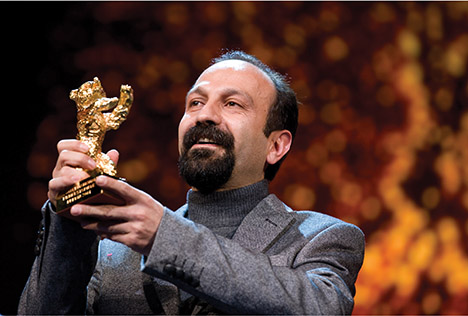
Asghar Farhadi with the Golden Bear for Nader and Simin, A Separation, courtesy Richard Hübner/Berlinale
See also for German version of this post.
An opening with political gravitas. Before he introduced the International Jury, Dieter Kosslick brought an empty chair on to the stage with a sign bearing the name of Jafar Panahi. The Iranian filmmaker, whose Offside was shown at the Berlinale in 2006 when it was awarded a Silver Bear, had been invited as a member of Jury, but was not allowed to leave his country. The chair remained empty until the end of the festival. The work of the »Filmmaker of the World« was present in the festival’s programme with his films being shown in the Berlinale’s various sections each day. Isabella Rossellini, president of the jury, read out loud an open letter from Jafar Panahi where the artist wrote, among other things: »The world of a filmmaker is marked by the interplay between reality and dreams. The filmmaker uses reality as his inspiration, paints it with the colour of his imagination, and creates a film that is a projection of his hopes and dreams.«
The past ten years have seen Dieter Kosslick with his marvelous and so friendly team being responsible for the Berlinale and enthusiastically received by the audience. Every morning, there are long queues of patient Berliners who sometimes wait for hours to obtain cinema tickets for a programme that often handles serious and politicial subjects. The film festival enlivens what would otherwise be a rather dull February in Berlin. The heart of the Berlinale is at Potsdamer Platz where Kosslick welcomes his guests and the film fans wait for hours to see the stars from around the globe. Of course, there are also films about culture, art, cuisine, but also crime and slapstick. Moreover, the European Film Market has become well established and Beki Probst is satisfied.
I know some guests who come from afar for the sake of the Retrospective – this year’s was dedicated to Ingmar Bergman – or to enjoy the eclectic programme offered by the Panorama.
The Germans love Westerns! John Wayne was, of course, simply brilliant. But the same goes for what the Coen Brothers do. So, the Berlinale had »hit the bulls-eye« by choosing True Grit as the opening film When the retrospective The American Western 1903-1961 was shown at the Oberhausen film festival in 1965, the audience stormed the cinema. There has never been a retrospective as successful since in Oberhausen.
Topics: Misc. | Comments Off on Berlinale 61 by Dorothea Holloway


